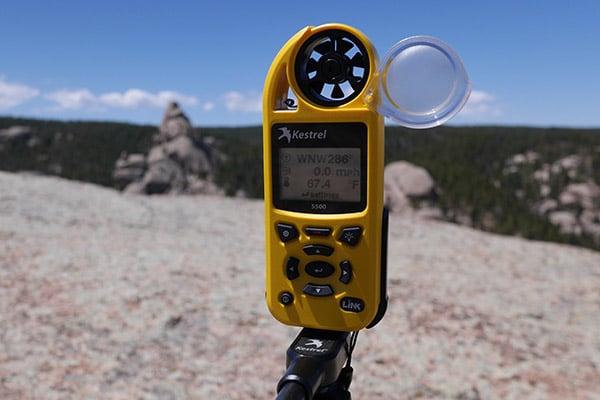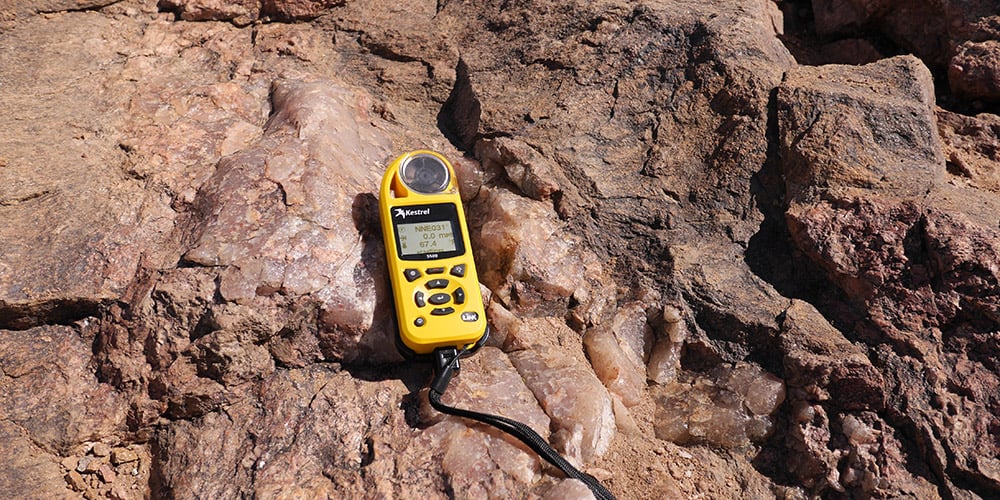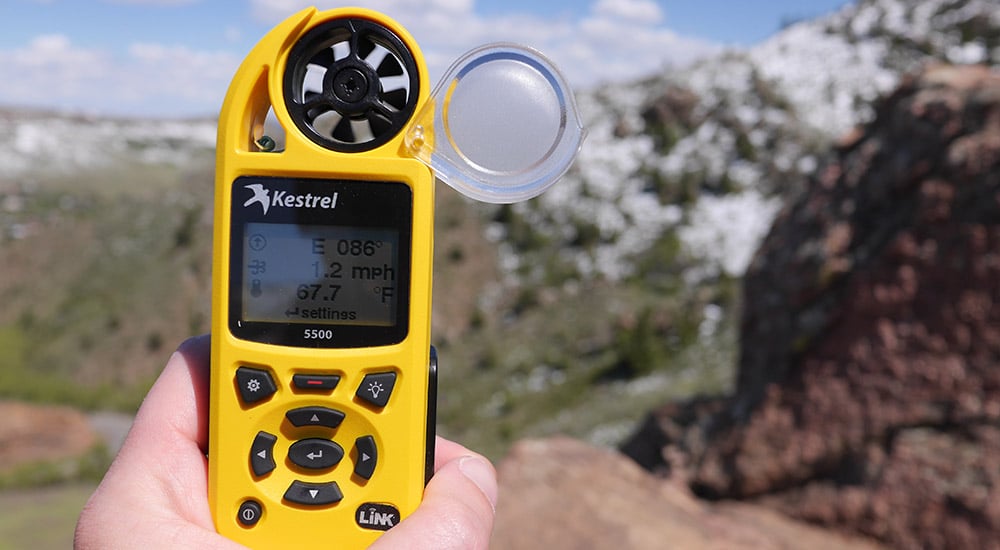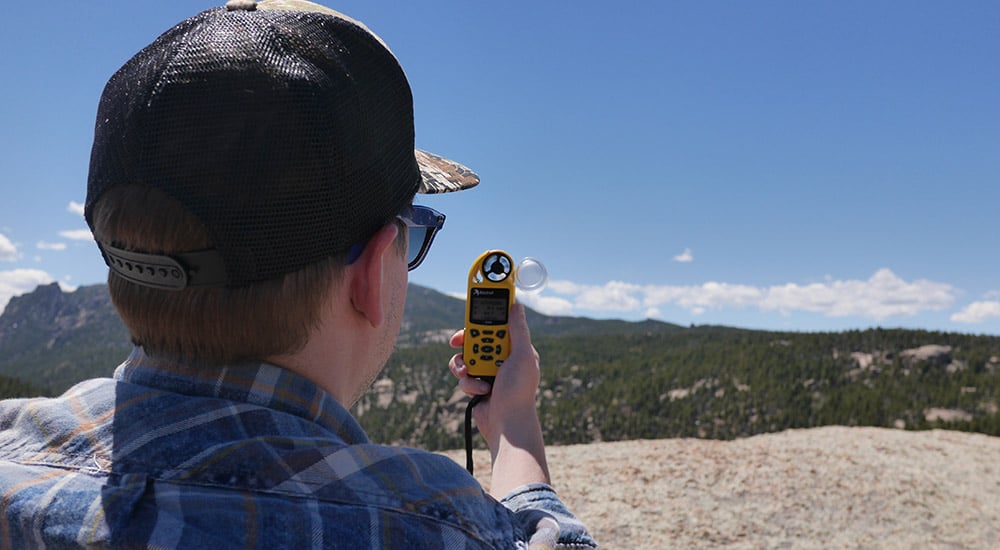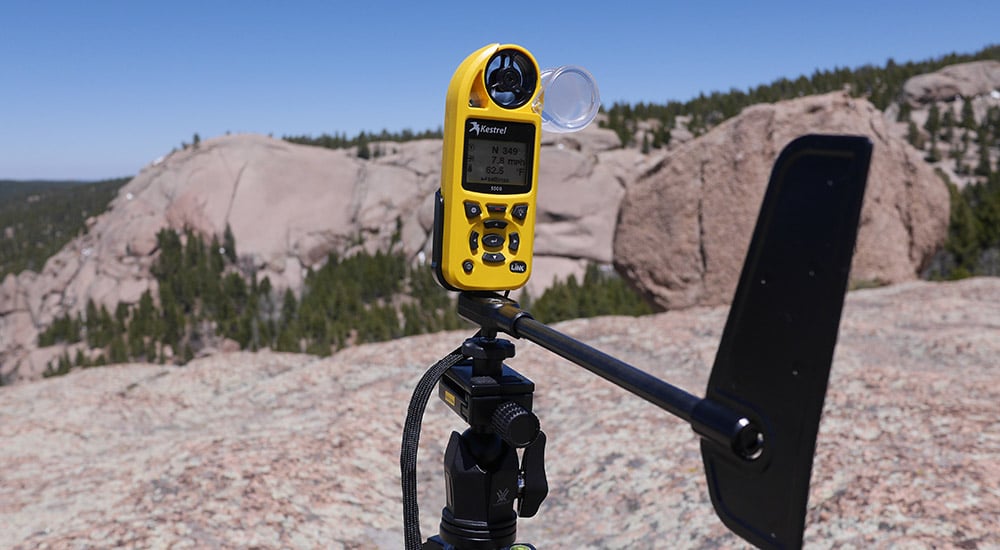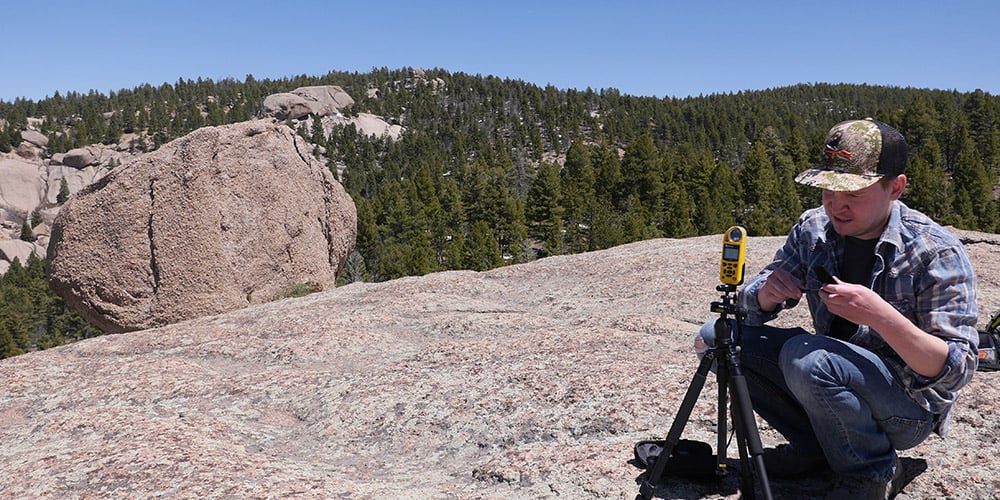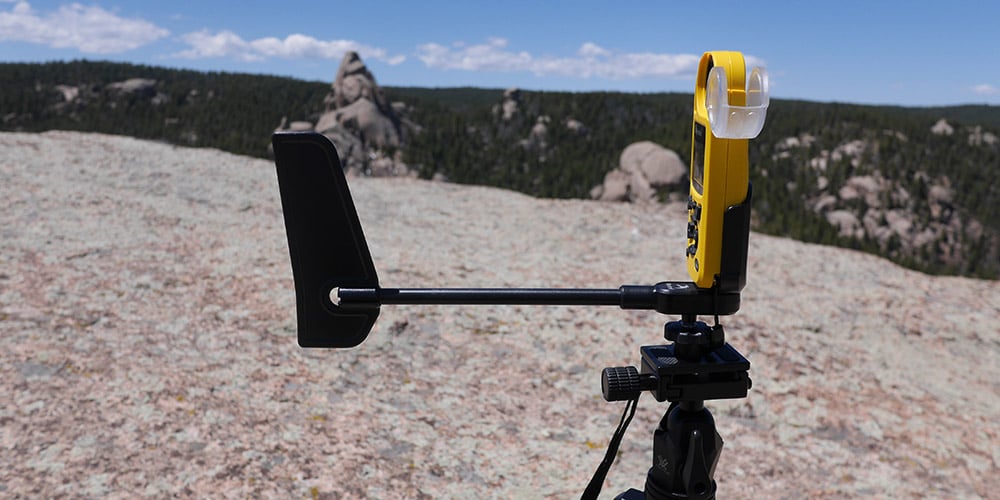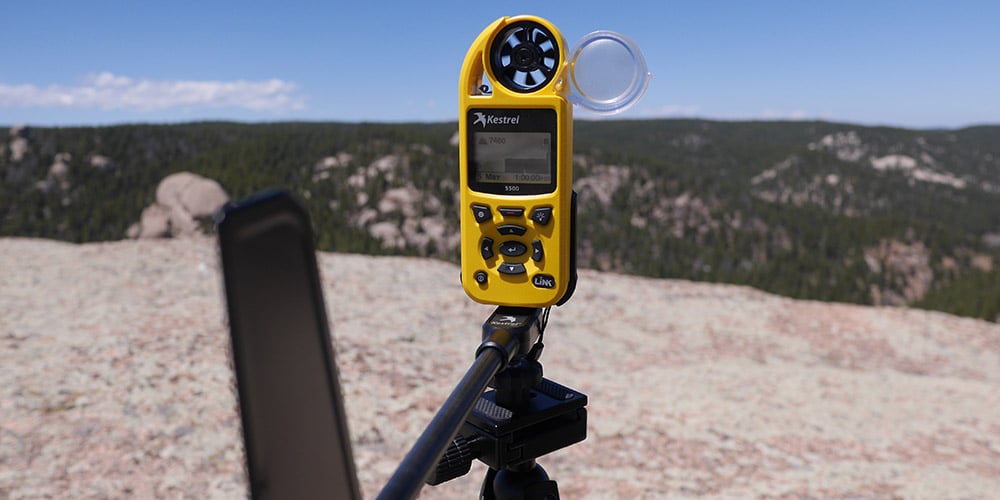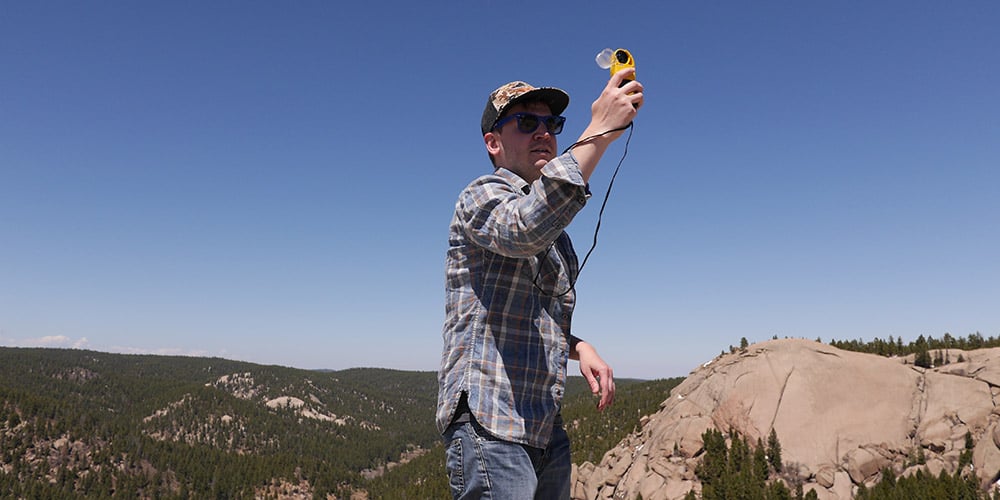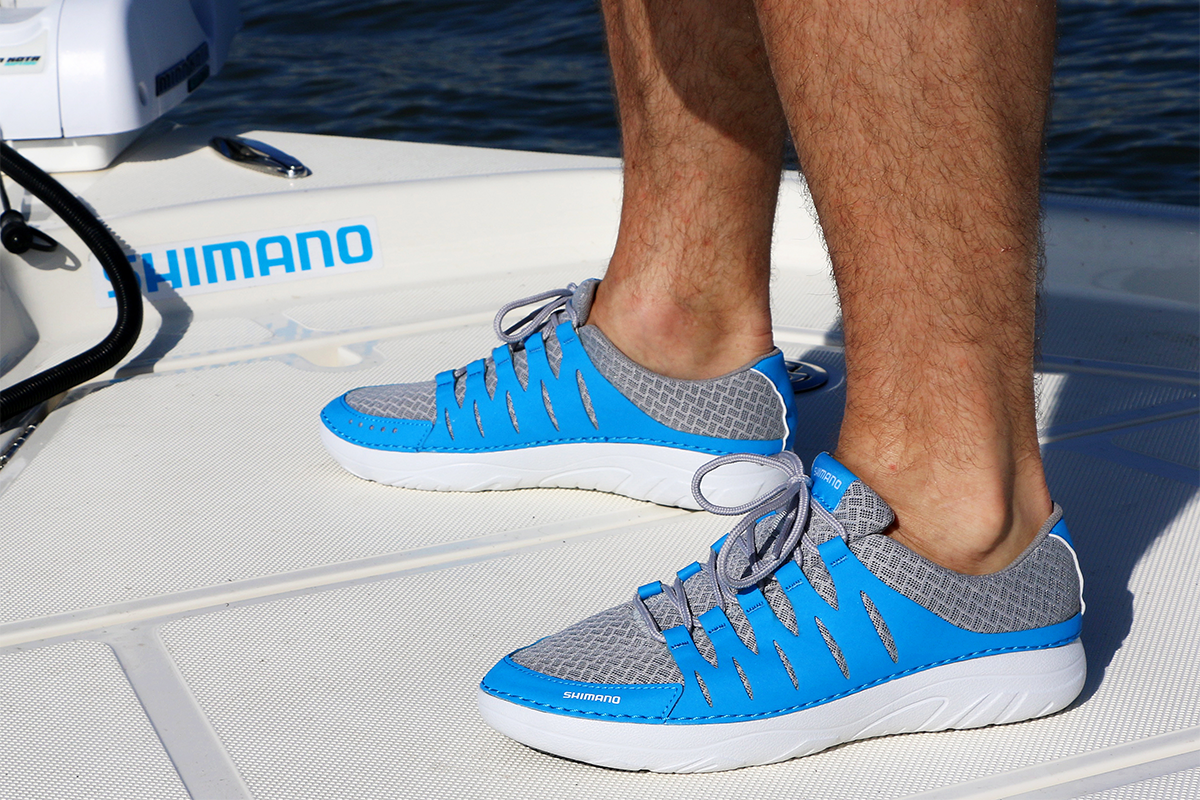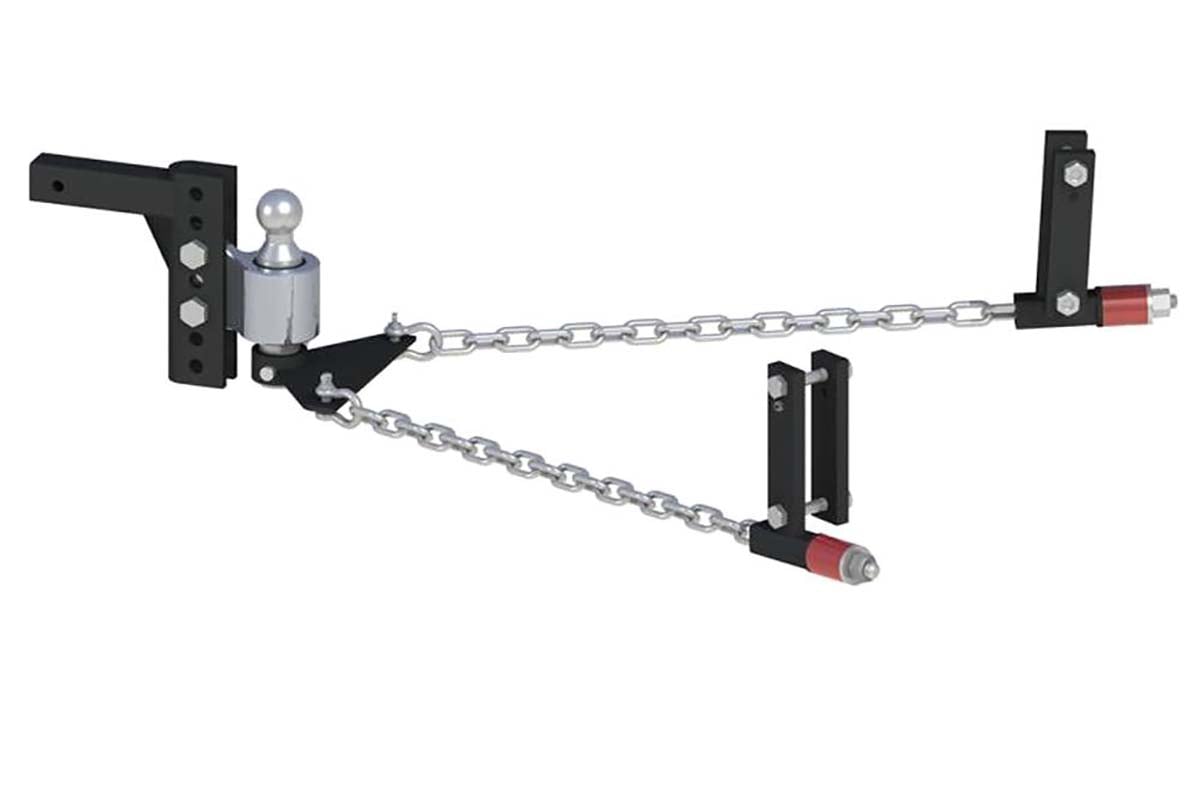Last Updated on
By David Link
The Kestrel 5500 Weather Meter is a standalone weather station that works independently or with your smartphone. It provides precise data measurements for everything from temperature to altitude. This device is a must have for weather hobbyists, hikers and campers, and other outdoor adventurers.
Recently, I reviewed the Kestrel DROP 3, a surprisingly advanced yet extremely compact weather meter that works with your smartphone. Today I’m going to look at a more advanced option from Kestrel, the 5500 handheld weather meter. This model offers three huge upgrades that are welcomed in the Rockies where I live – wind speed measurement, digital compass heading, and especially altitude measurement. Let’s check out this extremely versatile weather meter and see what it can do in the field while camping and hiking.
Basics
While the Kestrel DROP requires a smartphone to provide live atmospheric measurements, the 5500 offers and easy to read screen right on the device. This said, you can still link the Kestrel 5500 to your smarphone via the Kestrel LiNK app to log data on your phone. You can log and store data directly on the 5500 device as well, and it holds up to 10,000 data points. There is a dedicated backlight button that illuminates the screen in bright white or a subtle “night vision” orange for use in low light, and the screen is easily visible without light when used in the daytime.
Color And Extras
Depending on your intended use, it may be advantageous to get the 5500 in a bright color. The device is featured in a bright yellow (what I tested) so you won’t lose it if you set it down on a rock or in the brush. You can opt for flat earth or dark green colors if you need to keep the device concealed. The Kestrel 5500 comes in two different packages. Weather vane models offer extras to convert the device into a mobile weather station including a a tripod mount, a wind vane and extender bar for the vane. Effectively you can mount the device on a tripod and it will measure wind speed and wind direction (in addition to the other measurements) all on its own. The 5500 is available in models without the wind vane extras if you decide you won’t need this feature. Every model comes with a rugged nylon carrying case and a lanyard that can be hung around your neck or your wrist to keep the device from hitting the ground.
Sensor
As far as sensors go, the 5500 has a similar housed bulb sensor found on the DROP, however it is slightly smaller and handles a few extra duties. This sensor provides a wealth of measurement options including wet bulb temp if it is exposed to water. (Note: For precise measurement, the bulb should receive air flow and not be covered. Prolonged exposure to the sun can impact the accuracy of some measurements) On the other side of the bulb is the larger wind impeller that measures wind direction, crosswind and headwind / tailwind. There is a clear plastic cover that flips to the side when you want to measure wind speed, but otherwise you can leave it over the impeller to protect it as you travel. The wind impeller and cover are well-built and function seamlessly. While the entire device is shockproof to these specs: (MIL-STD-810g, Transit Shock, Method 516.5 Procedure IV), the impeller is a bit more sensitive and can be damaged, and replacements are easily obtained from Kestrel.
Battery Details
Another big upgrade in the Kestrel 5500 comes in the battery case. It holds one AA lithium battery in a waterproof case, and the housing is separate from the motherboard. In past models, battery corrosion caused damage to some devices, but Kestrel has corrected this in the latest 5500 models. Even so, Kestrel is careful to warn users, lithium batteries are the preferred power choice, and alkaline batteries must be removed while not in use to prevent corrosion. You also have to switch the system settings to “alkaline battery” if you use one in a pinch. (Battery corrosion is a real issue, and something I encounter regularly in my headlamps after use in the high country. It’s certainly not to be taken lightly, and it’s not worth cheaping out on the superior lithium battery option). The Kestrel 5500 can run up to 400 hours before the battery needs replaced, however use in colder temperatures, use of the back light, and use of the bluetooth connectivity feature can impact overall battery life. While we’re at it, the Kestrel should not be operated in extreme temperatures, and it’s operating range is listed as 14 to 131° F.
Specs
- Easy to read screen with optional white and orange backlight illumination.
- Shockproof (MIL-STD-810G) and waterproof (IP67).
- Exterior temperature, humidity and pressure sensor.
- Flip out plastic cover that protects impeller used to measure wind speed and related measurements.
- Easy to replace impeller.
- Uses 1 AA lithium battery (included) with up to 400 hours run time (alkaline batteries not recommended).
- Links to smartphone to use Kestrel LiNK App. Can also link to PC with Kestrel Dongle (sold separately).
Measurements
- Heading (True & Magnetic)
- Wind direction
- Crosswind
- Headwind/Tailwind
- Altitude
- Pressure Trend
- Barometric Pressure
- Wet Bulb Temperature
- Relative Humidity in %
- Heat Stress Index
- Dewpoint
- Density Altitude
- Wind Chill
- Air, Water, and Snow Temperature
- Current, Average, and Maximum Air Velocity
In The Field
I’ve been able to test the Kestrel 5500 Weather Meter on several hikes and camping trips this spring / summer. I plan to make further use of the 5500 this fall on an elk hunt, where temperature, wind chill and pressure changes will be more extreme and could have a bigger impact on my movements. First thing is first, I’m overwhelmed by the features and measurement options that this device offers. Just like when you get a new digital camera, it takes a learning curve to figure out everything the device does. You’re certain to find new features months after you bought it. Unless you’re a weather scientist, the Kestrel will be a work in progress for a general user as they get to know exactly what the device can do. This is a big benefit for most, as they’ll be able to discover more as they use the device. This all said, you can turn on the device and get immediate measurements on many important atmospheric factors right away, and you’ll be instantly immersed in what is going on around you.
On one occasion, I climbed up to a bald mountain to set up the Kestrel 5500 as a weather station, complete with the wind vane hardware included in the carrying case. I’ll admit, I was nervous to step away from the tripod the 5500 was mounted on, especially since wind gusts were swelling at 20-25 miles per hour at the time. Even if the device is shockproof, I didn’t want to see it take a dive onto solid rock. But once I stepped back to let the setup function, I saw that the Kestrel 5500 operated seamlessly as a mobile weather station. As each wind gust picked up, the 5500 and its wind vane moved smoothly to track wind direction and speed. It was pretty cool to watch, and it showed me that this device could accurately track wind direction and speed no problem. As long as your tripod is level to the terrain and firmly setup, you can just let the 5500 do the work on its own. Of course you can stand back with the Kestrel LiNK and track the data while you watch as well.
One other feature I’d like to touch on quickly is the in-screen graphs on the device. As you browse through the measurement options with the arrow keys on the 5500, it will bring up various bar graphs for data like altitude, temperature, wind chill, heat index, and more. This is a great way to evaluate environmental changes on the fly without having to view graphs on your smartphone. Does it feel like it is getting dangerously hot during the day? Check the heat index graph to see if there has been an upswing. Feel like temperatures have taken quite a dip in the past few minutes? The temperature graph will give you visual clues right away. This is a great way to interact with the data, and it’s a feature I really appreciated during my testing period.
Kestrel 5500 vs. DROP
I encourage you to compare my recent review of the Kestrel DROP3 with the 5500 to see which model better fits your needs. I’m impressed with both devices, and each offer distinct advantages depending on your intended use. Just because you’re new to weather meters doesn’t mean you have to go the route of the DROP right off the bat. In many ways the Kestrel 5500 is more accessible for beginners because you can interact with the device directly on its screen. Of course the 5500 is larger and more expensive, and this may be a limiting factor for some. You can’t go wrong with either device, but the addition of a compass, wind meter and altitude meter (different than Density Altitude offered in both models) make the Kestrel 5500 a more appealing option for those who spend a lot of time in the wilderness.
Final Thoughts
It is easy to become disoriented when you’re out for a hike or setting up camp. Temperature, dangerous heat index or wind chill factors, and even general compass direction are easy to lose track of. Carrying a pocket weather meter can keep you informed of all these factors and more. Take this example – on a recent camping trip with friends, we secured a scenic spot next to an alpine lake. It was at a decent altitude (10,000 +), and you could see the treeline break on the ridges above the site. Soon after we set up, the questions from others began: “It feels cold…what temperature is it?” Next came concerns about altitude: “How high are we?” It only took a few seconds with the Kestrel 5500 Weather Meter to answer everyone’s questions and look like a boss. I don’t believe I’ll head out without it on a trip anytime soon. This device is well worth keeping in your pack, and it might just save you from an unpleasant experience in the bush.
I haven’t even touched the activities of aviation, fire fighting, farming, and sailing, but as far as hiking and camping go, this device is a valuable addition to your gear collection.
